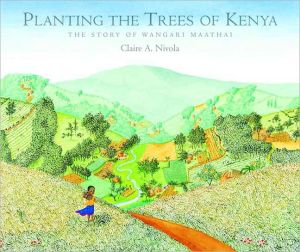Planting the Trees of Kenya: The Story of Wangari Maathai
Wangari Maathai, winner of the 2004 Nobel Peace Prize and founder of the Green Belt Movement, grew up in the highlands of Kenya, where fig trees cloaked the hills, fish filled the streams, and the people tended their bountiful gardens. But over many years, as more and more land was cleared, Kenya was transformed. When Wangari returned home from college in America, she found the village gardens dry, the people malnourished, and the trees gone. How could she alone bring back the trees and...
Search in google:
Wangari Maathai, winner of the 2004 Nobel Peace Prize and founder of the Green Belt Movement, grew up in the highlands of Kenya, where fig trees cloaked the hills, fish filled the streams, and the people tended their bountiful gardens. But over many years, as more and more land was cleared, Kenya was transformed. When Wangari returned home from college in America, she found the village gardens dry, the people malnourished, and the trees gone. How could she alone bring back the trees and restore the gardens and the people?Bill McKibben, author of The End of Nature, says: “Wangari Maathai’s epic story has never been told better—everyone who reads this book will want to plant a tree!”With glowing watercolor illustrations and lyrical prose, Claire Nivola tells the remarkable story of one woman’s effort to change the fate of her land by teaching many to care for it. An author’s note provides further information about Wangari Maathai and the Green Belt Movement. In keeping with the theme of the story, the book is printed on recycled paper.Publishers WeeklyText, pictures, subject and pacing all contribute to the success of Nivola's (Elisabeth) picture book biography of Wangari Maathai, the 2004 winner of the Nobel Peace Prize. In the first pages, Wangari watches her mother in the garden; the pale mountains, blue sky and profusion of growing things testify to Kenya's primeval beauty. Educated at a Benedictine college in Kansas, Maathai returns to her native country to find the land stripped for commercial farming. Others sigh; she is galvanized. She stands among women whose colorful skirts belie their poverty, and she teaches them to plant trees. Not even Kenya's soldiers escape her campaign: "You hold your guns... but what are you protecting?" she demands. "You should hold the gun in your right hand and a tree seedling in your left." Thirty million trees later, the soil-and small farms-thrive again. Simultaneously childlike and sophisticated, Nivola's paintings have the detail of tapestry and the dignity of icons. The idea of restoring ruined land to its original beauty will fill readers of all ages with hope. Nivola makes children feel it is possible for anyone to change the course of history if they set their mind to it. An author's note provides additional biographical and political details. Ages 5-8. (Apr.)Copyright © Reed Business Information, a division of Reed Elsevier Inc. All rights reserved.
\ From the Publisher“Wangari’s work, as so beautifully depicted in Planting the Trees of Kenya, will inspire people worldwide.” –Pete Seeger "The 2004 Nobel Peace Prize winner, Wangari Maathai changed the world one seed at a time. Claire A. Nivola's lovely Planting the Trees of Kenya offers Maathai's story to a younger, wider audience. No child, and surely no library, ought to be without Planting the Trees of Kenya." —Boston Globe\ “A stirring biography about her extraordinary life, with focus on courageous efforts to reforest Kenya and empower women.” —The San Francisco Chronicle\ "Simultaneously childlike and sophisticated...The idea of restoring ruined land to its original beauty will fill readers of all ages with hope." —Starred, Publishers Weekly "Beautiful . . . The story of how each human and tree can make a difference will inspire young people, who will want to linger over the wide, double-page landscapes." —Starred, Booklist "The delicately detailed illustrations suit the equally low-key writing style...This tale of civic responsibility, personal initiative, and conservation of natural resources is a timely one." —Starred, School Library Journal\ “There’s plenty to discover in the intricate pen-and-watercolor illustrations; the text is more detailed and will engage older children.”—American Scientist\ "Possesses a detailed, naive charm that beautifully explicates Maathai's social progress as she instructs women, schoolchildren and even prison inmates in the benefits of planting and nurturing trees...This impressive effort will resonate with children."—Kirkus Reviews "As an illustrator, Nivola . . . creates absorbing, telltale images—sweeping views of the countryside with miniature human figures, in the manner of folk paintings . . . .The whole is as much a pleasure as an inspiration." —The Horn Book “Claire Nivola gives us a wonderful story about Wangari Maathai, the winner of the 2004 Nobel Peace Prize and the founder of the Green Belt movement.” —Rondi Brouwer, Blackwood & Brouwer, Kinderhook, NY "Nivola's sotry delivers the idea that each of us can make a difference. Older readers will appreciate Nivola's detailed note about Maathai's life and her Green Belt Movement." —The Sacramento Bee "Wangari Maathai's story is beautifully told, is just the right length for young readers, and boasts wonderful illustrations that capture the beauty of this African country." —Book Loons \ \ \ \ \ \ Publishers WeeklyText, pictures, subject and pacing all contribute to the success of Nivola's (Elisabeth) picture book biography of Wangari Maathai, the 2004 winner of the Nobel Peace Prize. In the first pages, Wangari watches her mother in the garden; the pale mountains, blue sky and profusion of growing things testify to Kenya's primeval beauty. Educated at a Benedictine college in Kansas, Maathai returns to her native country to find the land stripped for commercial farming. Others sigh; she is galvanized. She stands among women whose colorful skirts belie their poverty, and she teaches them to plant trees. Not even Kenya's soldiers escape her campaign: "You hold your guns... but what are you protecting?" she demands. "You should hold the gun in your right hand and a tree seedling in your left." Thirty million trees later, the soil-and small farms-thrive again. Simultaneously childlike and sophisticated, Nivola's paintings have the detail of tapestry and the dignity of icons. The idea of restoring ruined land to its original beauty will fill readers of all ages with hope. Nivola makes children feel it is possible for anyone to change the course of history if they set their mind to it. An author's note provides additional biographical and political details. Ages 5-8. (Apr.)\ Copyright © Reed Business Information, a division of Reed Elsevier Inc. All rights reserved.\ \ \ Children's Literature\ - Elizabeth Fronk\ Wangari Maathai, winner of the 2006 Nobel Peace Prize, grew up on a farm with trees and streams filled with fish. She left Africa to attend an American college to study biology. After five years, Wangari returned to Kenya and saw how damaged Kenya's landscape was; most noticeable was the almost treeless land cleared to create more farms. Wangari realized that the people had forgotten to care for the land in order for the land to provide for the people. The women blamed others. Wangari stressed, "When we see that we are part of the problem, we can become part of the solution." She realized a simple but grand plan—plant trees. Her plan required hard work and depended on the women to carry out the plan, not the government or a lengthy education. She began the planting thirty years ago and has planted thirty million trees in Kenya. The author's note has further details about this amazing woman. The watercolor illustrations provide a folk-art and vast perspective to this brief biography. The concise text would be a good read-aloud for second or third grade students while middle school students could benefit from reading about this inspirational woman on their own. Reviewer: Elizabeth Fronk\ \ \ \ \ School Library JournalGr 2-4- Wangari Maathai, founder of the Green Belt Movement, was the first African woman to receive the Nobel Peace Prize. This simple story focuses on her conservation efforts, with little mention of her personal life and political struggles. Maathai studied biology in the United States in the early 1960s. When she returned to the newly independent Kenya five years later, she noticed that her country's natural resources were disappearing rapidly and that the people were growing poorer. She devised a strategy to reverse the desertification of Kenya by teaching women how to collect tree seeds and plant and nurture them. Since 1977, 30 million trees have been planted and her conservation lessons have moved across Africa and the world. The delicately detailed illustrations suit the equally low-key writing style. They effectively show the natural beauty of the landscape and convey the scope of the problems associated with deforestation. The artist is equally adept at portraying Wangari as she moves about the countryside and spreads her message among the people. This tale of civic responsibility, personal initiative, and conservation of natural resources is a timely one although it raises as many questions as it answers. An author's note provides a bit more background on Maathai's efforts. Add this to collections in need of easy materials on Kenya, conservation, or women leaders.-Carol S. Surges, McKinley Elementary School, Wauwatosa, WI\ \ \ \ \ \ Kirkus ReviewsLaced with gracefully told anecdotes, this picture-book biography examines the work of Kenyan Nobel Peace Prize-winner Maathai, who returned from college abroad to find her country ecologically imperiled. With the shift from small, local farms to large commercial ventures Kenya's trees were disappearing, women were forced to hunt further afield for firewood and desertification threatened. The story of Maathai's Green Belt Movement lends itself well to Nivola's treatment. The often-panoramic scenes of country and village life possess a detailed, naive charm that beautifully explicates Maathai's social progress as she instructs women, schoolchildren and even prison inmates in the benefits of planting and nurturing trees. In one effective spread, Maathai says to soldiers: "You hold your gun . . . but what are you protecting? The whole country is disappearing with the wind and water." In the facing painting Maathai stands before a group of attentive, black-capped, red-coated soldiers and gestures to a map of Kenya posted above a cheery row of potted seedlings. This impressive effort will resonate with children. (author's note, source note) (Picture book/biography. 5-9)\ \







